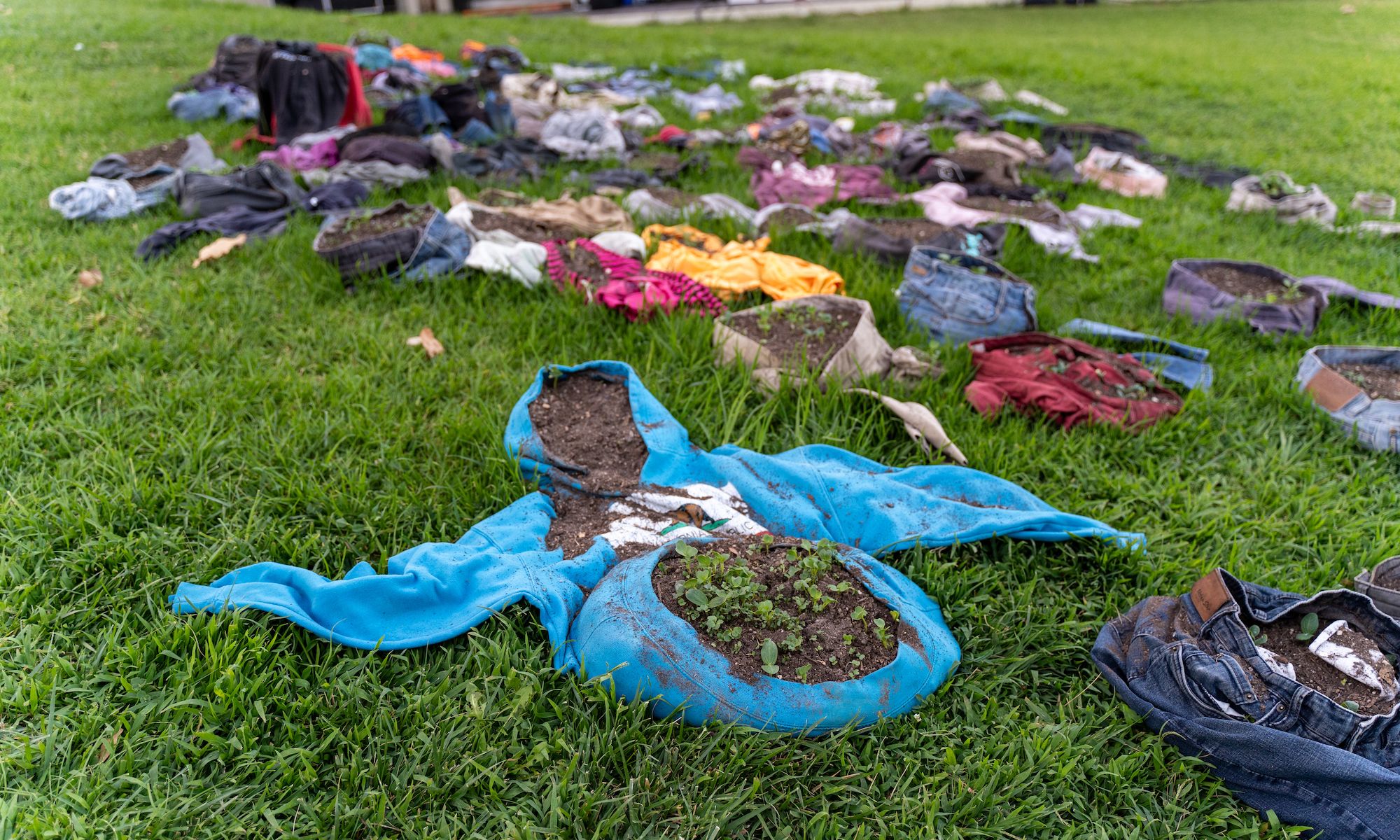Ruben Ochoa with Cam La, Ain't No Green Without Brown, 2023. Installation view at Earth Edition, 2023. Photo: Peter Galindo / Civic Center Studios
Sprawled on a grassy knoll on the campus of the California Institute of the Arts (CalArts) in Los Angeles are shirts, jeans and other clothing items, each filled with soil. From within, small sprouts emerge as seeds for alfalfa, radish, broccoli and more germinate. The unusual garden, set up last week, is an installation by the artists Ruben Ochoa and Cam La, who purchased the worn clothing from farmworkers in Oxnard, California, the majority of whom are of Latino descent. Titled Ain’t No Green Without Brown (2023), the work makes visible the labour responsible for feeding the US, while highlighting the challenges these essential workers face in a world of increasingly extreme weather.
“We set up a monetary exchange to purchase their sweat equity, clothing they used to work the fields,” says Ochoa, whose grandfather came to the US in the 1940s as part of the controversial Bracero Program. “Farmworkers still have to work through 90, 100 degrees [Fahrenheit], without a break, and they are still underpaid, living in poverty and a lot of them are undocumented.”
The installation is among the many works currently spread across the CalArts campus that aim to spur dialogue around the climate crisis, as part of a new festival focused on imagining better futures. Titled Earth Edition, a Festival of Eco-Consciousness (until 24 September), it features contributions from more than 50 artists and community groups. Organised by the speculative-design collective Visions2030, the ten-day event intends to go beyond raising awareness about climate change. Rather, in an era of seemingly endless apocalyptic news headlines, it is designed to help create a shift in public mentality that will inspire climate action.
Lumisphere interior at Earth Edition Photo: Joshua Brott
“We’re in a moment when the crises we’re facing are interlaced, and many people are experiencing a tremendous amount of anxiety and a sense of hopelessness, if not despair,” Yona Backer, co-director of Earth Edition, says. “So this event is a response to that. It’s an offering to focus on what is being done that’s positive, that’s solutions-oriented. How is it that we could create some experiences that help people either unlock for the first time or get back to a core sense of agency through their creative imagination?”
The festival’s centrepiece is The Lumisphere Experience, comprising a trio of interlocking geodesic domes by the design lab Minds Over Matter (Travis Threlkel and Marc Melzer). Inside, visitors are prompted to create their own visions for the future that are then exhibited in one dome and online, building a dataset of hopes and aspirational ideas.
Elsewhere, attendees can explore the sprawling exhibition Futuring (Art for Building New Worlds), curated by Vera Petukhova, in which works, many of them interactive, engage with world-building and sustainability. In addition to Ochoa and La’s installation, among others, a series of videos by Cannupa Hanska Luger depicts visionary Indigenous futures, a video game by Alice Bucknell takes on the issue of water scarcity, and ceramic kitchen tools by Emory Hall consider the future of dining.
Alice Bucknell, still from The Alluvials, 2023 Courtesy of the artist and Visions 2030
Not all participants are artists, and not every participating artist identifies as an eco-artist—a distinction that feeds into organisers’ goals to offer different entry points into how individuals are responding to environmental crises. “These are all people who have created some sort of initiative, some sort of locally based solution, some kind of hack for themselves or their communities to shift their sense of agency,” co-director Elizabeth Thompson says. “We are trying to help catalyse and inspire individual agency, because there are many things that an individual can do. But you need to feel some sense of optimism, that there is some leverage that you can utilise to change things in your own life and in your community.”
The festival aims to model sustainability innovations through its operations. It is working with companies such as Monkey Jean and World Centric to provide compostable food-service ware and proper waste disposal, and some building materials will be donated to CalArts. “We’re trying, on every possible level, to minimise our own carbon footprint by example,” Backer says. That goal is especially important given that the organisers hope to eventually bring the festival to other cities.
For their part, Ochoa and La plan to eventually distribute components of their living sculpture back to their communities: grown crops will be given away, and the majority of the soil will return to project partner Crenshaw Dairy Mart, an art centre in Inglewood.
“Ruben and I went into this not looking for solutions—our goal was just to shed light on climate change and how it affects farmworkers and also our food source, which is so important because it feeds us and future generations,” La says. “But just meeting with the farmworkers and being able to do this exchange, it’s been really impactful.”

